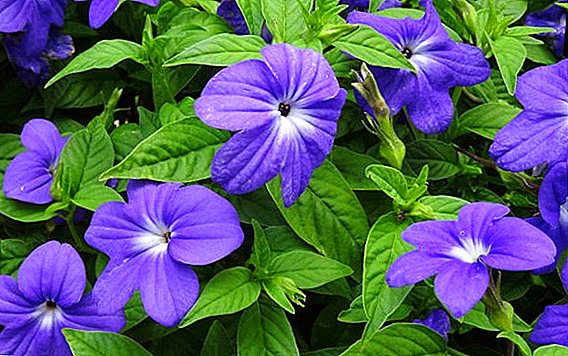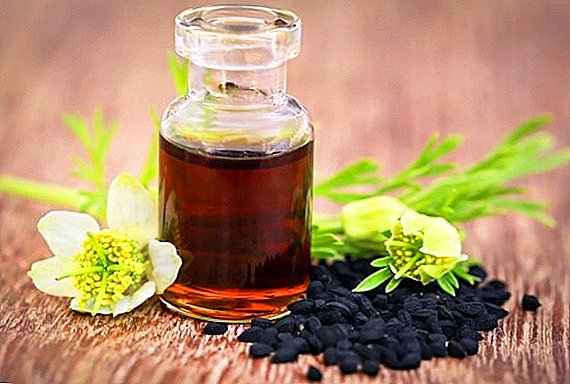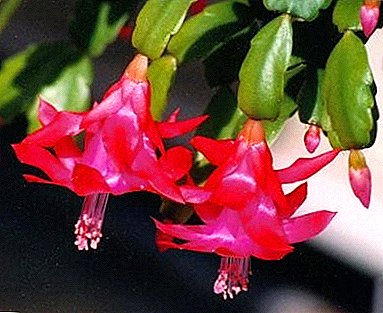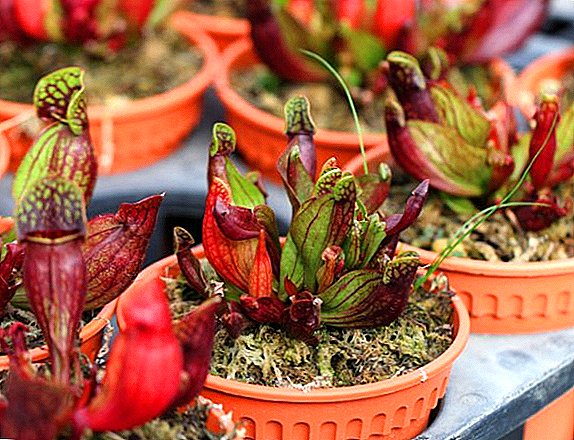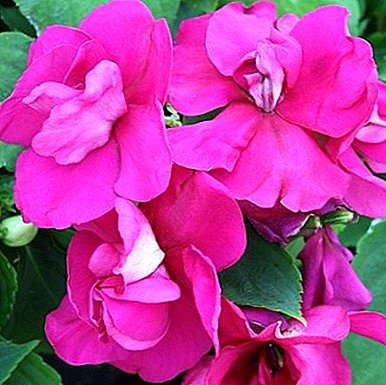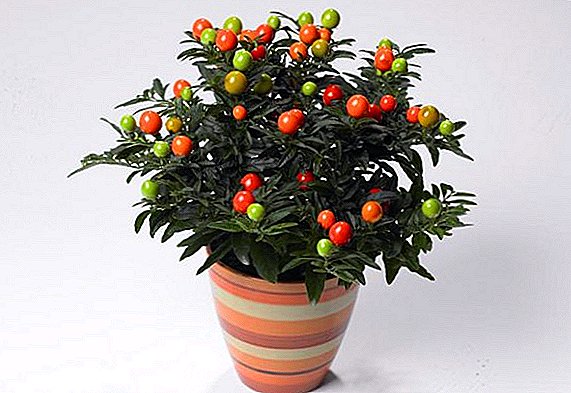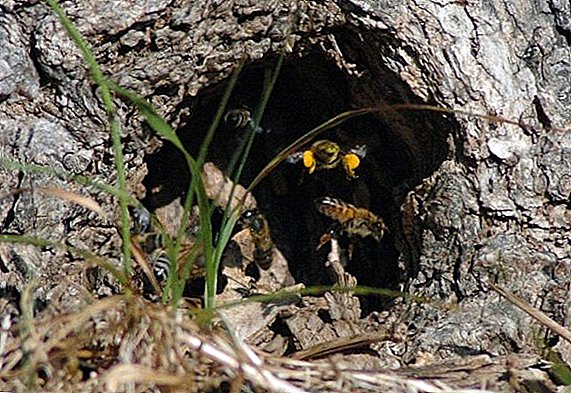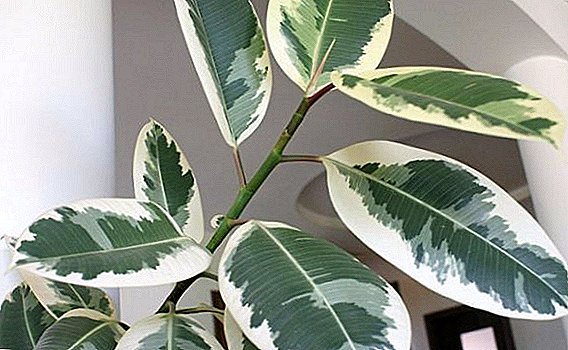 Among the huge variety of indoor plants it is impossible not to pay attention to the rubber plants. This is a very common type. They belong to the mulberry and there are up to 800 species. They are divided into 2 groups: variegated and green. Decorative ficus Tineke belongs to the first group.
Among the huge variety of indoor plants it is impossible not to pay attention to the rubber plants. This is a very common type. They belong to the mulberry and there are up to 800 species. They are divided into 2 groups: variegated and green. Decorative ficus Tineke belongs to the first group.
Description, photo, the birthplace of the flower
Ficus elastic, or ficus rubber - is also called Teineke. Homeland of this plant is Indonesia. In tropical forests, it grows to enormous size and looks like a large branchy tree. At home has a smaller size.
The young copy is a single-stem tree. Over time, it grows, branches, aerial roots appear on it. Because of these roots he was called snake. The roots, braiding the trunk, fall to the ground, where they take root and can give new sprouts.
Find out what other varieties of rubber ficus exist.
The leaves of the flower are consecutive, smooth, oval-shaped, have a pointed tip. Their length reaches 25 cm, and width - about 15 cm.  Drawing on the sheet is created due to the uneven distribution of shades of cream, white and green colors. At the same time in the center of the leaf blades darker colors are placed, and light ones are arranged at the edges. The central vein at the base has a width of up to 8 mm. In young leaves, the color of light green, in bright light, can change to pinkish. The stem is green and the petioles are light green. Stipules are pink, up to 19 cm in length.
Drawing on the sheet is created due to the uneven distribution of shades of cream, white and green colors. At the same time in the center of the leaf blades darker colors are placed, and light ones are arranged at the edges. The central vein at the base has a width of up to 8 mm. In young leaves, the color of light green, in bright light, can change to pinkish. The stem is green and the petioles are light green. Stipules are pink, up to 19 cm in length.
What to look for when choosing a plant
Recently, the ficus is becoming increasingly popular. It is especially relevant for country houses, where he will have enough space and lighting.
But when acquiring this handsome man, it is necessary to examine it carefully in order not to buy a sick plant:
- the flower must have a healthy appearance (without any spots or spots);
- leaves should be smooth and clean, without the presence of pests;
- roots peeping through the drainage hole should not have a black or dark brown color;
- shake a flower or run a hand over the leaves, if several leaves fall, it is better to choose another plant.
 Bring the flower home, do the following:
Bring the flower home, do the following:- wash it in a warm water shower;
- carefully wipe the leaves to remove the polish (treated in stores to add shine);
- set apart from other indoor plants for several weeks in quarantine;
- in the first days, the humidity should be higher than usual, and the light should be diffused;
- after a month and a half can be transplanted.
The best conditions for ficus Tineke
Tineke can be called an unpretentious and hardy enough flower. But in order for him to please you for many years, you need to know what conditions suit him best.
What should be the temperature and humidity
Growing in the tropics, plants, of course, belong to the heat-loving and moisture-loving. Therefore, the optimal temperature for Tineke will be from + 18 ° C to + 24 ° C. In summer, an increase of up to + 30 ° C is acceptable, but in this case the flower should be sprayed.
Spray boiled or filtered water at room temperature. Unboiled water can leave stains on the leaves.  In winter, it is better to keep the flower away from the heating devices. The temperature acceptable for it will be + 15 ° С- + 17 ° С. When the temperature decreases, leaves may fall. The ficus can endure a short-term cold, provided that the earth lump is not supercooled. If the plant makes a temporary cooling, a draft and root hypothermia does not. For this reason, flower pots should not be placed on a cold window sill or floor. It is not necessary to spray a flower wintering in a cool room.
In winter, it is better to keep the flower away from the heating devices. The temperature acceptable for it will be + 15 ° С- + 17 ° С. When the temperature decreases, leaves may fall. The ficus can endure a short-term cold, provided that the earth lump is not supercooled. If the plant makes a temporary cooling, a draft and root hypothermia does not. For this reason, flower pots should not be placed on a cold window sill or floor. It is not necessary to spray a flower wintering in a cool room.
Did you know? Ficus detrimental effect on bacteria. It reduces their quantity by 40%. He is also able to absorb and process such harmful substances as benzene, formaldehyde and phenol to form amino acids and sugars.
Flower lighting
As we have said, Tineke refers to variegated forms. And if you put it in a dark place, the color will turn pale and lose its decorative effect. Therefore, the flower should be placed on a sufficiently lit place. But direct sunlight is detrimental to it, as it causes burns and dropping leaves. The best place for the plant will be a window, located on the north side, where you can stay in it. If there is no such window, then apply a flower with a lowered curtain.
Ficus is in the 10-ke of useful indoor plants. In addition to it, useful properties are also highlighted: chlorophytum, aloe, geranium, laurel, Kalanchoe, chrysanthemum, cactus, pelargonium, sansevieria.
Soil and soil
Ficus need fertile soil, with good permeability of water and air. By acidity, it should be neutral or slightly acidic. From what age the plant depends on the composition of the soil. For young specimens, light and more friable soil is needed. It can be composed of:
- 1 part of leaf humus;
- 1 part sand;
- 1 part peat.
VIDEO: SOIL MIXTURE FOR FICUS OWN HANDS
Read about how to choose the right soil for ficus.Adult specimens prefer a denser substrate. The required density is given by adding humus or sod land. You can make this mixture:
- 2 parts peat;
- 1 part of the humus;
- 1 piece of leafy ground.
- 1 part of sand;
- 2 pieces of turf;
- 2 parts of leaf humus.
Important! When planting ficuses should be aware of the drainage. It must be of high quality, with the presence of expanded clay and charcoal. The latter will prevent stagnant water and rotting roots.
How to properly care for ficus Tineke at home
The appearance of young leaves every week throughout the spring and summer indicates the right care. In this case, the lower leaves also should not fall off. 
Correct watering
Although Tineke is from the tropics, it prefers regular and moderate watering. It is carried out in the summer at least 2 times a week, and in the winter - 2 times a month. Water for irrigation must be warm and separated. Once a month some manganese can be added to the water to prevent rotting of the roots.
Fertilizer and dressing
Year-round fertilizer is necessary when grown in inert substrates. When using soil mixtures, in the spring-summer period, supplements are alternated with mineral and organic fertilizers twice a month. Fertilizers "Ideal", "Kemira" and others are used for leafy ornamental plants. In winter, with a lack of lighting, active growth is not needed and it is better not to feed ficuses. In the spring and summer, during the period of active growth, fertilizing with a high nitrogen content is used. To reduce the concentration of fertilizer, it is added to water for irrigation.
You can spray the "Emerald" to improve the green mass of the plant. The first 2 months after transplantation fertilizing is not required.
Crown formation
The process of crown formation has a good effect on the growth of the flower and on its appearance. In order for the bush to develop evenly, from time to time it should be turned to the window on different sides. 
We recommend to learn in more detail how to form the crown of rubber-bearing ficus.
But basically crown formation occurs in 2 ways:
- using a sharp blade pruned shoots. The juice released on the slices is well washed off with water. Pruning stimulates the formation of new shoots, which contributes to bushiness. The best way is to trim up to 5-6 internodes. If the tree is single-stem, you can trim and then root the top;
- nipping the bush contributes and nip. The tops of the shoots are tender and brittle, so you can pinch them off manually.
Important! When working with ficuses, it is important to be careful. It is better to do everything with gloves, as the milky juice released during injuries, in contact with the skin, causes irritation, allergies and dermatitis.
Transfer
The question of how often a bush should be replanted can be answered by looking at the flower itself:
- the roots completely covered the earthen room;
- root system peeps and grows through drainage holes;
- soil in a flower pot dries quickly.
Read the detailed instructions for transplant ficus.
Transplantation is carried out in spring or summer. Young specimens are transplanted by transfer into a container that is 2-3 cm in diameter more than the previous one. This is done annually. A transplant consists of the following stages:
- the ground needs to be watered so that it is easier to get the bush from the pot;
- remove 2-3 cm of topsoil;
- remove the plant and earthen clod with roots, shake gently;
- place a bush in a new drainage tank;
- sprinkle well with soil mixture.



Features of reproduction of home ficus
If the bush is lush and you want to reproduce it, you can do it in 3 ways:
- the most effective is grafting. A stalk about 15 cm long is cut obliquely, lower leaves are removed from it. Milky juice rinses well with water. Practicing 2 ways of rooting, which we describe later;
- The second method is reproduction with the help of air layers. A small cut is made on the stem, into which a match is inserted so that the hole does not close. From above we apply wet moss and we wrap it with plastic film, fasten with adhesive tape. After the appearance of shoots, the shoot is cut off just below the layer with the roots and planted in the ground;
- the third way is the most ineffective. It uses a sheet that can be rooted in the ground or put into the water. But the most that will turn out at the same time is a leaf with a bunch of roots. Escape in this case is unlikely to succeed.


- cut cuttings are placed in a container with water (you can add activated carbon), which is placed on a bright place (without direct sunlight). It is necessary to provide high (about 80%) humidity and temperature not lower than + 25 ° C. After 2-3 weeks, the roots will appear and the cuttings are planted in the ground with a light structure;
- You can immediately put the cuttings in the soil mixture. Before this, you need to rinse the slice from the juice, dry and sprinkle with crushed coal. To create greenhouse conditions, the container must be covered with a can or plastic bag. It should be regularly watered and do not forget to air. The appearance of new leaves will mean that the growth of roots has begun. Young plants need to be opened more often, so they can gradually adapt to room temperature.
- the procedure is carried out in the warm season (spring or summer);
- ultraviolet is detrimental to young plants, so avoid direct sunlight;
- when grafting, one should know that young shoots do not form roots. For this purpose, cuttings with woody stems are used.
Diseases and pests of the flower
 If your pet is in adverse conditions, it starts to hurt. This can be understood by its appearance:
If your pet is in adverse conditions, it starts to hurt. This can be understood by its appearance:
- too dry air and direct sunlight causes yellowing of the leaves;
- lack of nutrients contributes to the shallowing of young leaves, yellowing and falling off of old ones;
- the appearance of brown spots indicates an oversupply of fertilizers;
- excess moisture causes yellowing of the leaves.
Important! In order to timely detect the disease or pests and take the necessary measures, the flowers must be carefully inspected once a week. In order to prevent the leaves can be cleaned once a month with a solution of soap.Among the fungal and viral diseases affecting ficuses, the following are known:
- chalcosporosis - characterized by the appearance of growing black or brown dots on the underside of the sheet. Treatment consists of spraying drugs with antifungal effects;
- powdery mildew - manifested by the appearance of a raid resembling flour. At an early stage, this scum is well washed off with soapy water. If the disease is triggered, only the use of the fungicide can help;
- the appearance of mold is characterized by gray rot The leaf is covered with brown spots, it darkens and falls. It is necessary to air the room more often, watering should be limited, the damaged parts should be removed, and healthy ones should be treated with a fungicide;
- the appearance of rusty spots on the edge of the leaf blade, turning into sores, is peculiar to anthracnose. Treatment, as in previous cases, is to spray the fungicide.

- shield. Its presence is indicated by the formation of convex brown spots on the seamy side of the leaf blade. This pest leaves a sticky liquid. The treatment consists of treatment with soapy water, and then with Aktellik. This procedure is carried out three times with an interval of 7 days;
- high humidity and temperature - excellent conditions for the appearance thrips (small black insects). Their presence is evidenced by the appearance of various spots provoking leaf fall. In this case, the spraying of "Aktar", "Tanrek", "Aktilik" helps;
- dry air causes spider mite. It leaves brown or grayish spots on the leaves. Later they dry and crumble. Humidity needs to be increased. To wipe a plant with soap solution. If this does not help, treat with an insecticide;
- deformation, yellowing and leaf fall may be a sign of aphids. Along with it appears a sticky liquid that attracts other pests that contribute to the spread of disease. To get rid of aphids are suitable the same methods as in the fight against spider mites;
- pests affecting the roots are nematodes. On the roots appear small growths. The danger lies in the fact that nematodes emit toxic substances that poison the plant. Bush should be removed from the pot, the roots for a couple of hours immersed in a solution of insecticides. After this procedure, transplant into a container with a new soil.


Did you know? Astrologers consider the ficus plant Capricorn. It helps to improve the emotional background of the room, relieves anxiety and anxiety.If you do not have this beauty, be sure to purchase. Happiness will live in your house with him. Use the tips and tricks from our article for the proper care of the ficus Tineke. Let it pleases you and your home for many years and cleans your home from harmful substances and negative emotions.
Feedback from network users



